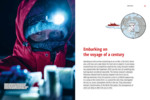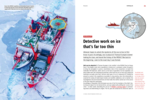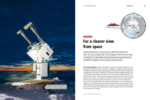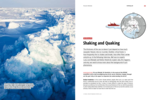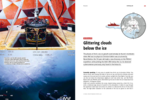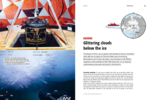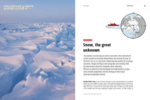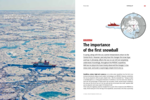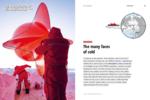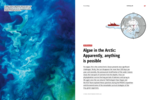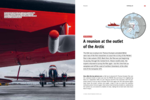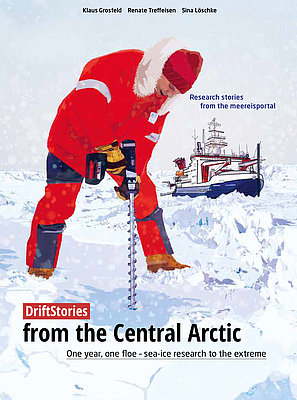Spending an entire winter researching on an ice floe in the Arctic Ocean was, until now, just a pipe dream for most sea-ice experts. It was always assumed that such an expedition would be too costly, the polar weather too unpredictable. But September 2019 saw the start of something that had long been considered impossible. Within the framework of the international MOSAiC expedition, the German research icebreaker Polarstern allowed itself to become trapped in the Arctic sea ice, offering researchers from 20 countries a once-in-a-lifetime opportunity. In a camp on the Central Arctic ice, around the clock they investigated the sea ice, ocean, atmosphere and life in the sea. They witnessed a dramatic transformation of the North Pole region, the consequences of which are likely to affect the sea ice first.
The editorial team of the meereisportal.de (seaiceportal.de) accompanied the sea-ice specialists taking part in the expedition during their work on the ice and reported on their backgrounds, methods, advances and findings in the portal’s DriftStories. In a total of ten stories, we introduced scientists from the expedition’s ICE team, highlighted their research fields and, in the form of online reports, provided more detailed information on the sea-ice-related work done on site and positioned the research in the context of the overall MOSAiC expedition.
Now these DriftStories from the Central Arctic have been published as a printed booklet, allowing you to immerse yourself in this unique expedition and be inspired by the challenges and experiences of the researchers on site. This publication brings together all ten stories with the goal of offering interested readers insights into the fascinating and surprisingly complex world of Arctic sea ice. The DriftStories gathered in the booklet are supplemented by an introduction that frames the topic of sea ice in terms of the ‘big questions’ concerning the changes taking place in the Arctic climate.
Read how the MOSAiC ice floe was found, how satellite measurements help to keep a macro-level eye on the Arctic sea ice, what role the thickness of the sea ice plays, what the scientists discovered beneath the ice of the MOSAiC floe, under what challenging conditions they built a runway on the ice, and how important it is to know the properties of the snow.
In addition, the booklet shares insights into the extensive technical equipment – the measuring devices, instruments and research platforms used, and stored in a special equipment container – and, through unique photos of the expedition participants, offers glimpses of an Arctic that might no longer be there tomorrow. Like our protagonists, you, too, can witness the transformation of the Arctic and experience, perhaps for the last time, the drift of the Arctic sea ice as we know it: the days of the Arctic’s hallmark snow and ice are numbered.
You can order the DriftStories free of charge by sending an email to infoprotect me ?!reklimprotect me ?!.de and providing your contact details and address, or you can download the digital PDF version.
Contact
- Dr. Klaus Grosfeld (AWI)
- Dr. Renate Treffeisen (AWI)
- Sina Löschke (science writer)
Questions?
Contact us via E-Mail or our contact form.
DriftStories from the 2019/2020 MOSAiC expedition through the Central Arctic as PDF for download
-
Spending an entire winter researching on an ice floe in the Arctic Ocean was, until now, just a pipe dream for most sea-ice experts. It was always assumed that such an expedition would be too costly, the polar weather too unpredictable. But September 2019 saw the start of something that had long been considered impossible. 426 KB
-
How AWI sea-ice physicist Thomas Krumpen is tracing the fate of the MOSAiC ice floes back to their roots. 355 KB
-
Satellite observation is the only way to effectively monitor the Arctic sea ice on a broad scale. Yet this approach still has its fair share of weaknesses. Unparalleled control measurements gathered during the MOSAiC expedition will now help to overcome them 508 KB
-
The thickness of Arctic sea ice depends not only on how much seawater freezes into ice during the winter. Another, increasingly important factor: how frequently the ice shakes and breaks up, floes collide and stack up to form ridges. In the following inter-view, AWI environmental physicist Luisa von Albedyll and sea-ice physicist Stefan Hendricks explain why this happens, and why we still need to learn more about the background of the phenomenon. 400 KB
-
The stages involved in the growth of Arctic sea ice could be found in textbooks back when AWI sea-ice physicist Christian Katlein was still at university. Nevertheless, during the MOSAiC expedition the 34-year-old made an exciting discovery: on a routine sweep under the MOSAiC floe with the AWI’s ROV, he observed a phenomenon previously only found in the Antarctic. 351 KB
-
How thick does sea ice have to be for aeroplanes to safely land on it – and how do you patch cracks in the landing strip? These and other questions confronted AWI sea-ice expert Christian Haas and his team when they began constructing a landing strip on the MOSAiC floe, in total darkness. They successfully completed the task – and were the first German polar researchers to ever do so. But the project also showed them that building a runway on the ice is a science of its own. 351 KB
-
The number of winter days on which snow falls in the Central Arctic can be counted on one hand. Nevertheless, the amount of snow on the Arctic sea ice is a key factor influencing how quickly the snow grows, and when it begins melting in the spring. But until recently, little has been known about this enigmatic white substance. AWI sea-ice physicists have developed and implemented a unique snow research programme, the first findings of which have attracted considerable interest. 369 KB
-
In spring, along with the sun, warmer temperatures return to the Central Arctic. However, precisely how this changes the snow layer and how it ultimately affects the sea ice are still not completely understood. Accordingly, throughout the MOSAiC expedition, AWI sea-ice physicists have closely observed the changes in the snow cover, and used a surprisingly simple trick to do so. 557 KB
-
In response to the question: “How cold does it get in the Arctic?” polar researchers will give you very different answers – depending on whether their work focuses on the atmosphere, snow and sea ice, or the ocean. As part of the MOSAiC expedition, scientists recorded temperature trends in all three contexts and analysed how they influence one another. One of their findings: even on the coldest winter day, there were temperature differences of up to 60 degrees Celsius! We asked the AWI experts how this was possible and what it means for the sea ice. Here are their replies. Combining these various scientific aspects helps us to arrive at a better overall understanding of the entire systems. 557 KB
-
For algae, life in the central Arctic Ocean presents two significant challenges: firstly, the sun disappears for more than 100 days per year; and secondly, the pronounced stratification of the water masses slows the transport of nutrients from the depths. How can phytoplankton survive the long periods of darkness and spring to life again once the sun returns? AWI biologist Dr Clara Hoppe and her ECO Team explored these questions during the MOSAiC expedition and discovered some of the remarkable survival strategies of the tiny, green organisms. 334 KB
-
The AWI sea-ice physicists Thomas Krumpen and Jakob Belter were two of the first researchers to scout the vicinity of the MOSAiC floe in late autumn 2019. Back then, the floe was just beginning its journey through the Central Arctic. Eleven months later, the experts returned to survey the floe again – but this time from an aeroplane and off the coast of northern Greenland, at the other end of the transpolar drift. 546 KB

